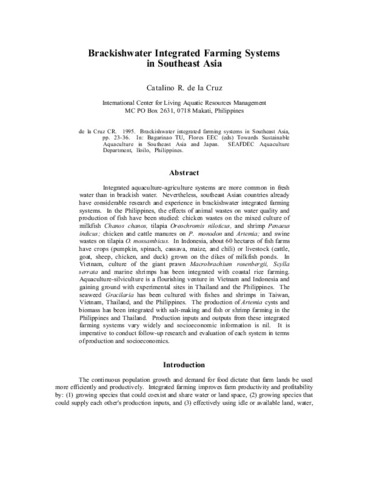Environmental capacity of receiving water as basis for regulating intensity of milkfish (Chanos chanos Forsskal) culture
| dc.contributor.author | Sumagaysay-Chavoso, N. S. | |
| dc.contributor.author | San Diego-McGlone, Ma. L. | |
| dc.contributor.author | David, L. T. | |
| dc.date.accessioned | 2013-09-24T14:06:57Z | |
| dc.date.available | 2013-09-24T14:06:57Z | |
| dc.date.issued | 2004 | |
| dc.identifier.citation | Sumagaysay-Chavoso, N. S., San Diego-McGlone, M. L., & David, L. T. (2004). Environmental capacity of receiving water as basis for regulating intensity of milkfish (Chanos chanos Forsskal) culture. Journal of Applied Ichthyology, 20(6), 476–487. | en |
| dc.identifier.issn | 1439-0426 | |
| dc.identifier.uri | http://hdl.handle.net/10862/1677 | |
| dc.description.abstract | This paper presents the results of the assessment of the environmental condition of a receiving water and demonstrates how the environmental capacity of the system can be estimated based on effluent discharge from milkfish ponds and water criteria from scientific literature and other studies. An estuary (average volume, 295 333 m3; average depth, 1.9 m) in Punta Pulao, Dumangas, Iloilo, Philippines served as discharge and irrigation system for commercial milkfish ponds and experimental/verification ponds owned by the Southeast Asian Fisheries Development Center. Total ammonia nitrogen, nitrite, nitrate, phosphate, and chlorophyll a (chl a) were determined monthly (during spring tide) for 4 months. Samples were taken at low and high tides that coincided with the draining and flooding of ponds, respectively. Monthly concentrations of these water quality variables generally increased from the first to fourth month of sampling (April–July 2001) during low tide. Very slight increases were observed during high tide. The magnitude of changes in the diurnal patterns of phosphate, chl a, and dissolved oxygen appeared to be higher at spring tide than at neap tide. This indicates that the inflowing river at low tide (during spring tide) brought effluents containing high amounts of nutrients from ponds located upstream. The water, salt, dissolved inorganic nitrogen (DIN), and phosphate (DIP) budgets of the entire estuary were determined following the one-box model by LOICZ-IGBP (2000, LOICZ biochemical budgeting procedure: a tutorial pamphlet. L. T. David, M. L. San Diego-McGlone, C. J. Crossland and S. V. Smith (Eds). Publ. for LOICZ International Project Office, the Netherlands, 29 pp.). The budgets indicate that the system is net heterotrophic and nitrogen (N) fixing during the dry months, but that there could be no environmental impact during the rainy months because of short water exchange time. Results further suggest that the system is a source of N and phosphorus (P) during the dry and rainy months; the condition is largely influenced by the high amount of nutrient inputs in to the river. Linear regression analysis was performed to determine relationship between nutrient concentrations in the system and total DIN or DIP input to the system at low tide. Environmental capacity in terms of the maximum amount of DIN or DIP input to the system was predicted using regression analysis and following set criteria for nutrients, i.e. nitrite, nitrate, and phosphate. At present, the estuarine water quality has already reached its environmental capacity during the dry months. About 945 ha of commercial milkfish ponds are operating upstream, mostly as extensive systems. If these ponds are converted to semi-intensive or intensive systems, it is recommended that the pond area be reduced to 122 ha if the DIP criterion is to be followed so as not to exceed the environmental capacity. Exceeding this environmental capacity may affect production through reduction of fish growth, occurrence of diseases, and fish mortalities. | en |
| dc.language.iso | en | en |
| dc.publisher | Blackwell Publishing | en |
| dc.subject | milkfish | en |
| dc.subject | Chanos chanos | en |
| dc.subject | Philippines, Panay I., Iloilo | en |
| dc.title | Environmental capacity of receiving water as basis for regulating intensity of milkfish (Chanos chanos Forsskal) culture | en |
| dc.type | Article | en |
| dc.identifier.doi | 10.1111/j.1439-0426.2004.00577.x | |
| dc.citation.volume | 20 | |
| dc.citation.issue | 6 | |
| dc.citation.spage | 476 | |
| dc.citation.epage | 487 | |
| dc.citation.journalTitle | Journal of Applied Ichthyology | en |
| seafdecaqd.library.callnumber | VF SJ 0790 | |
| seafdecaqd.databank.controlnumber | 2004-39 | |
| dc.subject.asfa | marine fish | en |
| dc.subject.asfa | estuaries | en |
| dc.subject.asfa | culture effects | en |
| dc.subject.asfa | water quality | en |
| dc.subject.asfa | aquaculture effluents | en |
| dc.subject.asfa | environmental impact | en |
| dc.subject.asfa | tidal cycles | en |
| dc.subject.asfa | mineral nutrients | en |
| dc.subject.asfa | pond culture | en |
| dc.subject.scientificName | Chanos chanos |
Files in this item
| Files | Size | Format | View |
|---|---|---|---|
|
There are no files associated with this item. |
|||
This item appears in the following Collection(s)
-
Journal Articles [1256]
These papers were contributed by Department staff to various national and international journals.



